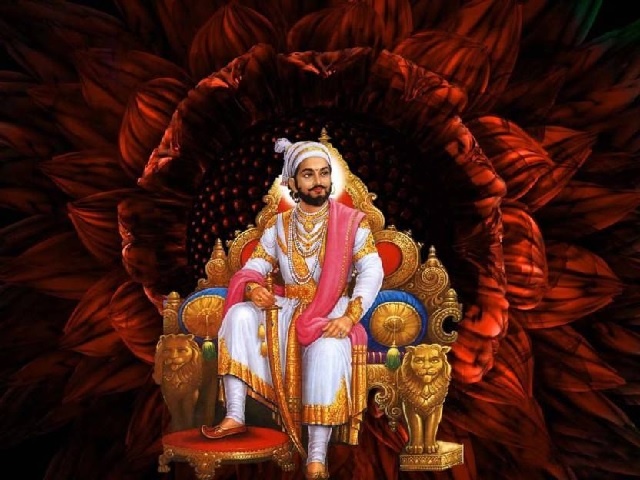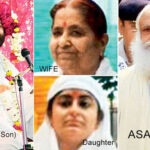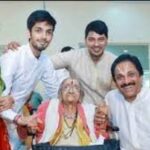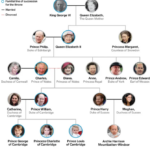In-depth details about Chhatrapati Shivaji Maharaj’s Family Tree members.
Babaji Bhosale, born in 1549, had two sons, Maloji Bhonsle and Vithoji Bhosle. Maloji Bhonsle was born in 1570, his next wife Umbai Nimbalkar had two sons, Shahaji and Sharifji. Shahaji Maharaj Bhosle was born in 1594 and Sharifji was born in 1596, Shahaji also had 3 sisters Jijabai, Tukabai, Narsabai.
Rajmata Jijabai Azizabai, known as Ausaheb, had two sons, named Sambhaji and Shivaji. Tukabai’s 2 sons were named Ekoji and Koyaji as well as Narasabai’s son’s name was Santaji.
Shahjiraje Bhosale was a Maratha general, and also the father of Shivaji Maharaj, the creator of the Maratha Empire in India. He was born on March 18, 1594. He died on January 23, 1664.
Chhatrapati Shivaji Maharaj has been the earliest Chhatrapati and the creator of the Maratha Empire. He is also known as Shivaji Bhosle. His mother has been Jijabai. Shivaji Maharaj was born on 19 February 1627 and died on 3 April 1680. Shivaji Maharaj was born in 1630 and had 2 sons, named Sambhaji and Rajaram. Sambhaji Maharaj was born in 1657 and Rajaram Maharaj was born in 1670. This Maratha Empire Bhosle’s descendants lived in Kolhapur and Satara. Since Sambhaji Maharaj was the youngest son of Shivaji Maharaj, we will tell his descendants further.
Ekoji was Shivaji Maharaj’s younger brother. He established the Maratha Empire at Thanjavur.
Sambhaji Shahji Bhosle (born: 1823, abolished: 14) He was a senior citizen of Shivaji Maharaj. His mother has been Jijabai.
His mother has been Saibai. He was the second Chhatrapati and ruler of the Maratha Empire. He was born in 1657 and died in 1689. Sambhaji Maharaj had 1 son, his name was Shahu, Shahu Maharaj was composed in 1682. He adopted the second Rajaram i.e. Ramaraja. Ramaraja was first born in 1726.
Chhatrapati Rajaram Maharaj was the younger brother of Sambhaji Maharaj. His mother has been Soyarabai. He was the third Chhatrapati and also the Emperor of all Maratha Empire. He was born in 1670. He died in 1700.
Chhatrapati Shivaji II was the son of Rajaram Maharaj along with Queen Tarabai. After Rajaram Maharaj left and Tarabai crowned his son and commanded the Maratha Empire.
His mother has been Yasubai. He became the fifth Chhatrapati of all Maratha Empire.
The second Shahu Maharaj Bhosle was composed in 1763, his son Pratapsingh has been appointed. Tej Pratap Singh Maharaj Bhonsle was built in 1793 and embraced the next Shahaji. The next Shahaji was built in 1802, he retained the throne from 1839 to 1848, also known as Appaji.
He was succeeded by the third Rajaram Maharaj Bhosle from 1874 to 1904.
After this, the next Pratap Singh Maharaj Bhosle was Chhatrapati from 1714 to 17-25. The next Shahu Maharaj Bhosle has been Chhatrapati from 1925 to 1960. The third Pratapsingh Raje Bhosle was Chatrapati from 1960 to 1978.
Udayanraje Bhosle who is a Chhatrapati from 1978 till now 20-19.
Babaji Bhosle
Babaji Bhosle, born in 1549, had 2 sons, Maloji Bhonsle and Vithoji Bhosle. Maloji Bhonsle was born in 1570, his second wife Umbai Nimbalkar had 2 sons Shahaji and Sharifji. Shahji Maharaj Bhosle was first born in 1594 and Sharifji was born in 1596, Shahaji had 3 sisters Jijabai, Tukabai with Narsabai.
Rajmata Jijabai
Jijabai Shahji Bhosle has been the mother of Shivaji, the Maratha king, who built one of the largest empires in the history of India. A ruthless warrior and administrator himself, he was instrumental in Shivaji’s efforts to start that Maratha empire. She acted as queen regent in her child’s kingdom for which she is commonly called Rajmata Jijabai. A winner of Hind Swaraj who went against the Mughal Empire that woman is one of the most inspiring historical figures of the country. Upon her birth, let’s recall some interesting details about Rajmata Jijabai.
Jijabai was born from Sindhkhed town in Maharashtra on 1-2 January 1598 to a distinguished Maratha chieftain and Malasa Bai Lakhuji Jadhavrao. Jadhavrao was a proud Maratha who served the Nizamshahi of Ahmednagar.
Jijabai was married at a very early age to Shahji Bhonsle, son of Maloji Shieldar. Her husband served Nizam Shah. They had eight children, for example six daughters and 2 sons. One was Shivaji.
Jijabai’s prayers were answered as Shivaji became an independent ruler of the Maratha clan. He, who served as her mentor, was instrumental in her achievements.
He invited Shivaji to avenge the death of his eldest son Sambhaji as a result of Afzal Khan meeting Shivaji.
Jijabai has been famous for her virtue, valor and foresight, which she gave to her son Shivaji. She was also a skilled cavalryman and had a method with swords that embarrassed enough fighters.
While queen regent, he managed his wife’s fiefdom in Poona and saw its development. He built the Kasbapetha Ganapathi temple and rebuilt the Kewareshwar temple along with the Tambadi Jogeshwari temple.
Only twelve days after Shivaji’s coronation, he passed away in 1674 at the village of Pachad near Fort Rajgarh.
Shahajiraje Bhosale
Shahaji was that the son of Maloji Bhosale, who was the famous Maratha warrior. He was born in 1594 or in 1602 and expired on January 23, 1664 AD. Bhosale participated in several wars in favor of Nizam Shah of Ahmednagar. So that he awarded Jagir of Pune and Supe districts. Maloji as a Hindu, Fantastic devotee of Sufi Muslim pir Shah Sharif. He telephoned his sons Shahaji and Sharifji to honor the pir. His mother was the daughter of Lakhuji Jadhav, the another famous Maratha general.
As the elder kid he acquired Pune and Supe Jagirs following his Father. He was quite expert from the Guerrilla struggle and brought his family to the limelight in the History. Shivaji Maharaj, the founder of Maratha Kingdom has been the son of Shahajiraje. When Mughal emperor Shah Jahan began the invasion of Deccan, Raje Bhosale assisted the Emperor to conquest Deccan. Later he defeated the Bijapur Sultanate in 1632 AD and strongly controlled over Pune along with Supe. In 1638 AD, Bangalore came under his hands and also invaded the Kempe Gowda III’s territories.
Defied and Alliance with Mughals
Shah Jahan sends a massive Mughal army to ruin the Nizams. Afterward, Adilshah allied together with the Mughals. At that time, Shahaji Maharaj was at the fort of Mahuli.
Shahahji Raje seeks for help from Portuguese, but the Portuguese won’t supply support. Consequently, Nizam had no choice left except to surrender before Mughals to save Prince Murtaza’s entire life. After the treaty, Mughals had rescues Nizam Prince Murtaza.
Then, the Mughal emperor Shah Jahan delivered Shahaji to south India. At that moment, there was an incident in the court of Nizam, in which Shahajiraje’s fatherinlaw Lakhujirao Jadhav was murdered in the courtroom. Thenin anger, Shahji Raje renders the Nizam court and accepted service in Adilshahi court.
Like Malojiraje, Shahaji Maharaj was also very gallant. He Had fought many conflicts in favor of their Nizamshah. At that moment, Shahaji helped Mughals to defeat Adilshah at the year 1632. Mughals given the region won in this war to Shahaji Raje Bhosale.
Maharana Pratap of Mewar used the guerilla warfare method Like wise, being out of the creation of Shahaji Maharaj, he was very skilled in guerrilla war.
Following This, Shahji had fair hands over the Pune and Supe.
After coming to Adilshahi court, Shahjahan and Ranadullah They intended to win the southern Parganas(regions) from the year 1638.
To build a harmonious and serene connection together, They conquered many championships in the south east and returned their kingdoms to them. Consequently, if Shahaji Raje Bhosale demands help later on, the support of these sins begun in the future.
Karnataka Campiagns Of Shahaji Maharaj
Kempegowda was clearly one of the Terrific ruler of Karnataka who Established famous city of Bangalore. His successor named Kempe Gowda-III was contemporary successor ruling during the right time of Shahaji Maharaj.
Kempe Gowda-III of Karnataka also dominated the country of Karnataka under the effect of the Vijayanagar kingdom. In 1638 AD, Bijapur’s army defeated Kempe Gowda-III, under the leadership of Shahaji Raje and Randullah Khan.
Shahaji Prisoned from Adilshah
One day Bhosale delivered Shivaji and Jijabai to Pune to seem There Shivaji started capturing the lands under Adilshah around Pune. This left mad to adilshah and caught Shahaji and clutching him. The competitive Shivaji approached Shahjahan and seek assistance against Adilshah. This made fear to Adilshah and released Sambhaji. 1 day Shahaji went to hunting on his horse, regrettably , he falls off the horse and expired approximately 1665 AD. His tomb was constructed at Hodigere close present Channagiri Mandal at Karnataka.
Politics Of Shahaji Maharaj
Even though Shahaji Raje at Adilshahi courtroom, Shivaji Maharaj, Started his attempts to catch the forts one by one. He consequently won Torna, Rajgad, Pratapgad, Kondhana, Purandar, Rohida, Panhala. Subsequently, Adilshah inquired about Shivaji Maharaj into Shahaji Raje. At that moment, Shahaji claimed the specific problem saying,”As there was no fort to manage the work of legacy of Pune and Supe Paragana (region), Shivaji might took the fort”
Here, Shivaji Maharaj additionally reported through reporter together with an Message,”Forts have been taken only to take care of the Pune and also Supe land correctly. There was not any moto behind it” This way, Chhatrapati Shivaji Maharaj Gradually keeps up the work of Swarajya.
Shahaji Maharaj’ Death
Once while Shahaji Maharaj was Karnataka wished to search. He had been in Hodigere village. For hunting, he heads to the deep forest. It was the afternoon of 3rd January if Shahaji Raje was searching in the Jungle. That moment an accident happened, they fell out of the horse directly to the bottom. He died on the spot as a result of mind hitting the floor. The news of Shahaji Raje’s death spreads such as the wind through the duration of India. When as Jijabai got a letter to Raigad fort, the mountain of grief falls upon her and her family.
Shahaji Raje was the most influential chieftain of India in His period. Increase in India. His son Ekoji-1 or Vyankoji was the creator of the Maratha Empire at Tanjavur. In memory of his own daddy, Vyankoji constructed the grave of Shahaji Raje in Hodigere village near Channagiri taluk in Karnataka.Chhatrapati Shivaji Maharaj
Chhatrapati Shivaji Maharaj
Shivaji, also spelled Śivaji, (born February 19, 1630, or April 1627,” Shivner, Poona [now Pune],” India–expired April 3, 1680, Rajgarh), creator of the Maratha kingdom of India. The kingdom’s security was founded on religious toleration and on the operational integration of the Brahmans, Marathas, and Prabhus.
Early life and exploits
India At that time was under Muslim rule: the Mughals from the north and the Muslim sultans of Bijapur and Golconda in the southwest. All three ruled by right of conquest, without a pretense they had some obligations regarding people that they ruled. Shivaji, whose ancestral estates were situated in the Deccan, in the realm of the Bijapur sultans, found the Muslim oppression and religious persecution of the Hindus so intolerable that, at the time he was 16, he convinced himself that he was the divinely appointed tool of the cause of Hindu freedom–a conviction that has been to sustain him throughout his lifetime.
Collecting a band of followers, he started about 1655 to seize The poorer Bijapur outposts. From the process, he crushed a few of the powerful co religionists, who had aligned themselves with all the sultans. The same, his military and fearless skill, combined with his own sternness supporting the oppressors of their Hindus, won him much admiration. His depredations grew increasingly unafraid, and many minor expeditions provided for chastise him demonstrated ineffective.
When the sultan of Bijapur at 1659 delivered an army of 20,000 Underneath Afẕal Khan to defeat himShivaji, pretending to be intimidated, enticed the force deep to challenging mountain terrain and then murdered Afẕal Khan in a meeting to which he had enticed him by submissive appeals. Meanwhile, the hand picked troops which was previously positioned swooped down to the unwary Bijapur army and routed it. Over night, Shivaji had become a powerful warlord, possessing the horses, the guns, and the ammunition of this Bijapur army.Alarmed by Shivaji’s climbing power, the Mughal emperor Aurangzeb ordered his viceroy of this south to fend against him. Shivaji countered by adhering to a daring midnight movie right within the viceroy’s encampment, at which the viceroy lost the fingers of one hand and his son has been murdered. Discomfited by this opposite, the viceroy withdrew his force. Shivaji, like to provoke the Mughals further, assaulted the coastal town of Surat and took immense booty.
Aurangzeb could barely ignore Therefore flaunting a challenge and Delivered out his most outstanding general, Mirza Raja Jai Singh, at the head of a military believed to host some 100,000 men. The pressure that was exerted with this vast force, together with the drive and tenacity of Jai Singh, soon compelled Shivaji to sue for peace and also to tackle he and his son could attend Aurangzeb’s court in Agra to be able to be officially accepted as Mughal vassals. In Agra, tens of thousands of miles from their homeland, Shivaji and his son were placed under house arrest, where they lived under the risk of implementation.
Escape from Agra
Undaunted, Shivaji feigned illness and, like a Type of Penance, started to send enormous baskets full of candy to be spread among poor people. On August 17, 1666, he and his son had themselves carried beyond their defenses in such baskets. His escape, probably the most thrilling episode in a lifetime filled with high drama, was to improve the class of Indian heritage. His followers welcomed back him as their boss, and over 2 years he’d only had won back all the lost land but had expanded his own domain. He collected tribute from Mughal places and plundered their rich cities; he reorganized the army and instituted reforms for its welfare of his or her subjects. Taking a lesson from the Portuguese and English traders who’d gained toeholds in Indiahe began the construction of a naval force; he was the very first Indian ruler of the time to use his own sea-power to commerce in addition to for defense.
Nearly as though prodded by Shivaji’s meteoric rise, Aurangzeb intensified his persecution of Hindus; he imposed a poll tax to these, connived at forcible conversions, and demolished temples, and erecting mosques in their places.
Independent sovereign
Amazing fanfare as a different autonomous. The suppressed Hindu majority rallied to him as their leader. A Hindu who prided himself as the protector of his religion, he broke heritage by commanding that two of his relatives, that were forcibly converted to Islam, ought to be hauled into the Hindu fold. Yet even though both Christians and Muslims usually imposed their creeds over the people by force, he admired the beliefs and secure the places of worship of both communities. Many Muslims were in their own services. After his coronationhis most noteworthy campaign was at the south, during which he forged an alliance with the sultans and thereby obstructed the expansive design of this Mughals to spread their ruler over the whole sub continent.
Shivaji had a couple of wives and two sons. His final years have been Inspired by the apostasy of the older son, who, at one stage, defected into the Mughals and had been brought back only with the utmost difficulty. The stress of protecting his kingdom from its opponents in the face of sour domestic strife and discord one of his ministers hastened his end. The man that British writer and politician Thomas Babington Macaulay (later Baron Macaulay of Rothley) called”the Great Shivaji” died after an illness in April 1680, at the mountain stronghold of Rajgarh, which he had left his capital.
Shivaji breathed new life into a moribund race which for Centuries had resigned itself to abject serfdom and directed them against Aurangzeb, A potent Mughal ruler. Above all, in a place and era stained by religious Savagery, he had been clearly one of few rulers that practiced authentic religious
Ekoji
Venkoji Bhonsle (born 1629) or Ekoji I Bhonsle was the younger half-brother of Shivaji and founder of Maratha ruler in Thanjavur. He had been the progenitor of the junior branch of the Bhonsle family that ruled Thanjavur until the official annexation of this kingdom by the British at 1855.
Early Life
Venkoji was Younger son of Shahji Bhonsle, also a military Commander operating of the Sultan of Bijapur during his spouse Tukabai Mohite. He triumphed on the jagir of Bangalore to the departure of his dad while his eponymous elder brother had chased an empire of his own.
Conquest of Thanjavur
In 1673, the Nayak of Madurai invaded the realm of Thanjavur under the rule of this Thanjavur Nayaks and drove away the ruler. Then he went to set his younger brother Alagiri Nayak on the throne of Thanjavur. That is resented by Rayasam Venkanna, a high-energy official in the court of Thanjavur who affirmed the origin of Chengamala Dasu, the deposed son of Vijayaraghava, the overdue Nayak of Thanjavur.
The Adil Shah sent Venkoji to invade Thanjavur and restore The throne into the old line of nayaks. Even a Sanskrit manuscript Bosalavamsavali narrates how Venkoji conquered Arni and proceeded into Thanjavur to liberate it from the shackles of their Nayak of Tiruchirapalli. However, Wilkes assigns various reasons for its usurpation of the Maratha. He’s of the opinion that Venkoji wasn’t delighted with the conduct of Chengamaldas who refused to pay the warfare expenses.
Founded by Rayasam Venkanna who had switched sides once More, Venkoji conquered Ayyampettai and conquered Alagiri who had also fallen out with his brother Chokkanatha Nayakas and Changamaldas and secured the throne for himself.
Reign
Dates of Ekoji I’s reign
The Marathi inscriptions of the Thanjavur temple dates the Capture of Thanjavur into January 1676. The Madras Tamil manuscript assigns the dates 1675 and also 1679 into the conquest and end of Ekoji I am predominate.
- However, Wilkes asserts that Ekoji was alive in 1686-1687. The documents from the British East India Company mention a king called Ekoji as late as 1699-1700.
But, Dharmakuta a comment on the Ramayana indicates This Ekoji might have abdicated from the year 1684 in favor of the son Shahuji. However, it is quite unclear as to how many years he lived after the occasion.
Clash using Shivaji
At 1676-1677 Chattrapathi Shivaji made an expedition into the Carnatic to claim his portion of the jagir of all Bangalore. With this aim in mind, he made a treaty with Golconda, took Gingee and proceeded to Thanjavur after beating all lands north of the Coleroon river. He set Vellore under the principle of a half-brother named Santoji. Ekoji I answered by establishing regular military attempts into Santoji’s territory with the intent of driving him off. But in 1680, Bijapur succumbed to the invasions of Shivaji and handed over the administration of all lands to the north of this Coleroon river to Shivaji. Ekoji I was forced to be a vassal of Shivaji and pay him tribute. On the death of Shivaji, however, the tribute was ceased and Thanjavur kept its separate presence.
Alliance using Ramnad
The chiefs of all Ramnad had been vassals of the Nayaks of Madurai. Nevertheless, the brand newest ruler Kilavan wished to eventually become independent. With this aim in mind, he also concluded an alliance with Ekoji I and rebelled against his overlord. The battle ended in the reign of Shahuji I using the defeat of Madurai and the liberation of all Ramnad.
Literature
Sanskrit and Telugu literature prospered during this period. The king himself is believed to have composed a Telugu variation of the Ramayana.
Sambhaji Shahaji Bhosale
Chhatrapati Shivaji Maharaj’s senior brother Sambhaji had been Born in the year 1619 at Verul. While he had been growing up, he was accompanying his dad Shahaji Raje, who was a sardar at Adilshahi. In addition, he utilised to assist his dad in the management of this territory of Bangalore and Kolar which were under Shahaji Raje’s get a grip on. When a number of the Adilshahi sardars conspired against Shahaji Raje, being a consequence of that he had been imprisoned by Adil Shah, Sambhaji valiantly defended Bangalore.
In 1654, Aap khan of Kanakgiri revolted against Adil Shah. Afzal Khan has been requested to quell this revolt. Sambhaji was also accompanying Afzal Khan. He attacked Kanakgiri with a platoon of troops. They failed to receive any help which Afzal Khan was supposed to let them have. Sambhaji lost his entire life from the attack on Kanakgiri. Subsequently Shahaji Raje succeeded in taking over Kanakgiri.
Chhatrapati Sambhaji Maharaj
Chhatrapati Shivaji Maharaj – the great Maratha warrior king. Shivaji Maharaj belonged to the Bhonsle clan and has been born on 19th February 1627. Shivaji Maharaj assembled the Hindawi Swaraj – that the Self-rule of Indians as against the of the Mughals who identified themselves as figures in Tamerlane of Mongolia and of Turcik – Central Asian (Chagtai) bloodline.
Chhatrapati Shivaji Maharaj died on 3rd April 1680 however also in His lifetime, he set the foundation for the genesis of the Maratha empire – a solid bulwark against offenses. His son Sambhaji Maharaj needed a massive task cut before him – to defend the Maratha empire against the might of the Mughals in Delhi who were later subdued and ravaged from the Maratha armies) also to carry on the policies and vision of Shivaji Maharaj.
Brahmin poet Kalash became his mentor
It is said that Sambhaji’s step mom wanted her son Rajaram to be king. For that reason, she used to incite hatred towards Sambhaji in Shivaji’s mind. This led into a state of mistrust between Shivaji and Sambhaji. Once, Shivaji had him imprisoned for a certain reason. By where he managed to escape. After this, he met the Mughals, but seeing that the barbarous nature of the Mughals towards the Hindus, he returned into his kingdom . While he had been escaping out of the imprisonment of Aurangzeb, he met with that the Brahmin poet Kalash, who later became his mentor.
Designed the Master-piece
He also had an inclination towards literature. He composed many Literary functions, which remain relevant today. He composed Budhacharitra in Sanskrit language in honor of his dad.
Departure of sambha ji
In 1665, the Treaty of Purandar was signed involving the Next, Shivaji died on 3 April 1680. At that Timing Sambhaji became king sacked his daddy’s partners from the article and He also appointed the poet Kalash because his mentor, that was a Resident of Mathura. He had no comprehension of Marathi language. This was Triggered by the insults of Shivaji’s allies against internal insurgency Due to this rebellion, Sambhaji dropped in He was subsequently held captive and subjected to acute Physical and mental torture, however, Sambhaji, a devotee of both Mahadev, didn’t give.
Chhatrapati Rajaram Maharaj
Chhatrapati Rajaram Maharaj: (February 24, 1670 – March 2, 1700). The youngest son of Chhatrapati Shivaji Maharaj and the third Chhatrapati of Maratheshahi. He had been born on Rajgad into Shiva’s wife Soyarabai. Is. After the death of Shivaji Maharaj, the eldest son Sambhaji Maharaj was crowned. March 1 1, 1689. Sambhaji Maharaj was savagely murdered. As a result of this incident, the full Marathi Swarajya was shaken. There are some folks who can think with good sense in such a difficult situation. Shivaji Maharaj had already got it. These included Ramchandrapant Amatya, Santaji Ghorpade, Dhanaji Jadhav, Shankaraji Narayan, Pralhad Niraji, etc.. All these congregations crowned Rajaram Maharaj (1689).
Because of Mughal invasion, Rajaram Maharaj needed to depart Raigad And go to Jinji. Is. He descended into the south and defeated Adilshahi (1686) and also Qutbshahi (1687). After this episode he abandoned for Bijapur to promote the military. Its purpose was to obstruct the share of the Marathi army originating from the north. From there, Aurangzeb came to Brahmapuri and started an effort to capture Gadkot of the Marathas and is of directing the Marathas in difficult circumstances came to Rajaram Maharaj. Currently Rajaram Maharaj was just 19 years old. After he got there, he kept his temper in check. Jinji had a chance of three lakhs. He was seized by the Marathas. The Maharaja filled the imperial palace with Jinji. He even gave the book’Hukmatpanha’ into Ramchandrapant Amatya. Appointed Santaji along with Dhanaji as commanders.
Zulfiqar Khan was accountable for beating Jinji. To Defeat Rajaram Maharaj, he came to Jinji with a strong army and laid siege to the fort. The siege lasted for eight decades. Rajaram Maharaj kept Zulfikarkhana in suspense by negotiating with him from time to time and successfully managed the siege. 30-35 million Maratha army assembled under the direction of Rajaram Maharaj. This army has been divided between Santaji and Dhanaji and the struggle against the Mughals started again. Santaji and Dhanaji brought the Mughal officers into Jeris during the siege.
The main Rustum Khan was attempting to conquer the Ajinkyatara community of Satara. Afterward Rajaram Maharaj, realizing the lack of assistance for Rustumkhana, sent Santaji and Dhanaji against Khan. The Marathas defeated Khan (January 25, 1690). In this struggle, the Marathas captured 4000 horses, but they recovered a nice of one lakh from Khan The success over Rustumkhana fostered the confidence of the Marathas. Rajaram Maharaj’s main task was to encourage and encourage that the Marathas in this life and death struggle. Chhatrapati, since the father and guardian of those public, did the job perfectly. Since the Marathas assumed the form of Raudra, the Mughals became dire straits.
Govalkonda were busy for three years from 1689 to 1691. In this period a wonderful opportunity was created for the Marathas. Even the Marathas who struggled with guerrilla warfare then started winning battles in the open field. By 1695, Aurangzeb began to come up with the notion of this fierce form of Marathas.
Rajaram Maharaj was immobilized at Jinji’s fort because of siege by Zulfiqar Khan. Aurangzeb sent more reinforcements, guns and ammunition to acquire Jinji. Zulfiqar Khan, that besieged Jinji, had a latent ambition to get the kingdom of Govalkonda. He had been the son of Wazir Asadkhana. Rajaram Maharaj gave him that the kingdom of Govalkonda, saying he spent 7 8 years at the siege of Jinji. Jinji’s siege is simply a drama, every one knew that. Rajaram Maharaj had shown Amish Kambaksh the same approach to get the kingdom. Maharaj wrote a letter directly into Kambaksh and told me he would set you about the throne of Delhi. Falling prey to this particular lust, Kambaksh planned to imprison Asad Khan along with Zulfiqar Khan. This made a lot of confusion at the army. Benefiting from this, the Marathas dropped over the Mughals in every guidelines.
Aurangzeb was demanding money from the chiefs of the northwest, As the salaries of the Mughal army were exhausted. In 1 year, lots of Mughal soldiers, horses, elephants, camels and mules were being killed. Due to the war situation for 27 decades, the grain which was becoming 10 20 paise per lion was being sold at the speed of 1 to 2 rupees per lion. This form of Mughal-Maratha battle was an evaluation of resources and endurance. All the Mughal armies were sick and tired of this long war. The Mughals had enormous funds, whilst the Marathas had immense endurance. Endurance finally defeated the instruments. Such a dire state of affairs, it had been necessary to defend the family of their Maratha soldiers. He kept all of the Marathi families safe from the neighborhood of Vishalgad as well as in the Konkan underneath the Sahyadri. The killing of Qasim Khan and Himmat Khan, the first course fighters of the Mughals, generated a feeling of dread in the Mughal army.
Rajaram Maharaj freed himself by the siege of all Jinji at the Right time and came to Vishalgad. After arriving to Satara out of Vishalgad, he decided the management of future expeditions. It was intended to strike Varhad and Khandesh, to strike Malwa north of Burhanpur, therefore the Mughal army would proceed north; However Rajaram Maharaj died at Sinhagad fort. Therefore, the aforementioned plan couldn’t be realized. These letters have been dated 1697, one of which will be addressed to Rajaram Maharaj and one other to Pralhad Niraji. The above plan is supported by these letters.
The temptations of Rajaram Maharaj is clear from the Decisions he has brought every once in a while. 1 significant thing they did was Proper decentralization of power. Some of the reasons for the downfall of the Mughal Empire was the decentralization of power in the palms of Aurangzeb. Rajaram Maharaj had to be given fresh lands to sustain those public. He gave books Such as’Hukumatpanha’,”Vajratmab’,’Himmat Bahadur’ into the Maratha generals, Gave equipment into the chiefs, gave them lands. Rajaram Maharaj conducted the Duties that a mature and hard working king has been designed to carry out.
Shivaji Bhonsle II
Shivaji Bhonsle II or Shivaji Rajaram Bhonsle (9 June 1696 — 14 March 1726) was the son of the Maratha Chhatrapati, Rajaram I, along with also his spouse Tarabai.
He had been born in Bhonsle family. Upon the death of his father, The baby Shivaji was installed as the Chhatrapati of the Maratha Empire with his mum Tarabai serving because the regent in 1700. His cousin, Chhattrapati Shahu up on his release from the Mughals in 1707 successfully contested Tarabai to turn into the following Chhatrapati. [inch ] Tarabai then establish a rival court in Kolhapur. Shivaji II functioned as Raja of Kolhapur from 1710 to 1714. At that time, he was again deposed by his own stepmother Rajasbai who installed her son, Sambhaji II on the Kolhapur throne. [2] Shivaji II posthumously became father of a boy, later called Rajaram II of Satara that was brought up in obscurity because of their own protection. After Shahu, with out a male heir to succeed to his throne, wanted to adopt a son, Tarabai revealed that fact to him late 1740s. Shahu adopted Rajaram II who triumphed Shahu because the Chhatrapati following Shahu’s departure.
Shahu II (1777-1808), or Aba Sahib, was the adopted son and Programmer of Ramraja. He was adopted by Ramraja before his death in 1777. Shahu II was born Vithoji Bhosale, his biological dad being Trimbakjiraje Bhosale of all Wavi. He was just a titular king and, as along with his predecessor, real power rested with the Peshwa. Shahu II died on 4 May 1808.
Pratapsinha
Pratapsinha (1808-1839) was the eldest son and successor of Shahu II. Since he became king in a younger age, his affairs were handled by his mother, Anandibai.
Her relations with the Peshwa, Bajirao II, were initially Cordial, barring letters of criticism regarding their allowable allowance. However, soon before the initial Anglo-Maratha war, Peshwa Bajirao II kept Pratapsinha a virtual prisoner in Fort Wasota in Satara. The cause of this was that the Peshwa was losing support from his Maratha sardars, so he wished to help keep the king under his control. Also, the Peshwa had received reports of Pratapsinha’s secret conspiracies with the British resident whom he expected would manage to free him of the Peshwa’s control. However, by 1818, Pratapsinha had started secret discussions with the British governor of Bombay, Elphinstone, during his confidantes, Narsu Jamadar and Balwant Malhar Chitnis.
As per a treaty between Pratapsinha and also the East India Company in 1819, James Grant was made the resident of this British East India Company. He was able to coach the king at the intricacies of government, where he’d been retained deprived by the Peshwa.
It was also decided that following the raja was sufficiently Trained in administration, power could be passed gradually to him. About 5 April 18-22, the king has been formally handed over his seal, and the fort of Pratapgad was ceded with him. James Grant additionally took leave of the king and left for Englan
After Grant there were lots of more British governmental representatives: John Briggs at 1823, William Simpson in December 1826, A Robertson in June 1827, also Lodwick at 1832. Pratapsinha shared with a cordial relationship with these residents, most of whom who had only praise for this particular eager, congenial, well meaning young king.
Company and also the king started to emerge. The king has been feeling dizzy and slighted over his own empowerment. Accusations began to be thrown straight back and forth between the parties, each charging the other with offenses of the understanding between them. The king was accused of running hostilities contrary to the organization, charges that the king vehemently refused. The king was also banished out of his kingdom and sentenced to Benaras. He along with his hometown managed to lead their lives to get a specified pension to take care of their sustenance.
Pratapsinha perished in Benaras on 14 October 1847.
Shahaji
Shahaji / Sayaji, also known as Appasaheb (1839-1848) has been He had a reign of seven years under the British resident, Charles Ovans, before his death on 5 April 1848.
Shahaji adopted a son, Venkoji (otherwise known as Bhauaheb Or Venkatji) on his deathbed. However, Venkoji was immediately deposed as the British refused to admit him because he had been perhaps not Shahaji’s child.
Shahaji hadn’t any natural son, so the kingdom of Satara had been Annexed to the British dominions in accordance with the short-lived Doctrine of Lapse. From that point onwards, their country of Kolhapur became the legitimate throne of the Marathas as recognized by the British.
Post-Shahajithere were clearly further chatrapatis in Satara but they only held a titular status:
- Venkatji (1848-1864) was the adopted son of Shahaji.
- Pratapsinha II / Rajaram (1865-1874) was Venkatji’s adopted son.
- Rajaram III (1874-1904) – adopted son.
- Anna Sahib (1904-1919) was the natural son of Rajaram III.
- Bhav Sahib / Bhausaheb (1914-1925) was the natural son of Rajaram III and brother of Anna Sahib.
- Captain Shrimant Raja Shahu Pratapsinhji Bhonsle Chhatrapati Maharaj (1925-1950) was also known as Chandrasen Bhosale. He was the adopted son of Bhau Saheb.
India became an independent republic in 1947 and all princely states were abolished, including the state of Satara.











